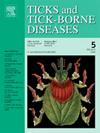Absence of Coxiella burnetii in kangaroo ticks (Amblyomma triguttatum) from a high seroprevalence population of eastern grey kangaroos
IF 3.1
2区 医学
Q2 INFECTIOUS DISEASES
引用次数: 0
Abstract
Q fever, caused by Coxiella burnetii, is an important zoonotic and public health concern worldwide. Kangaroos are thought to be a likely wildlife reservoir for C. burnetii in Australia and the kangaroo tick (Amblyomma triguttatum) has often been considered a vector. In this descriptive study of ticks collected from a population of eastern grey kangaroos (Macropus giganteus) with a high serological (84 %) and molecular (65 %) prevalence of C. burnetii in northern New South Wales, a total of 72 A. triguttatum ticks were tested by PCRs targeting the IS1111, htpAB, and com1 genes of the Coxiella genome. Despite the remarkably high prevalence of coxiellosis in the host population, none of the ticks were positive for Coxiella. This finding suggests that the kangaroo tick may not play a significant role in the transmission dynamics of C. burnetii in this particular host population.
东部灰袋鼠高血清流行种群中的袋鼠蜱(Amblyomma triguttatum)体内没有烧伤科克西拉菌。
由烧伤科克西氏菌引起的 Q 热是全球关注的重要人畜共患病和公共卫生问题。在澳大利亚,袋鼠被认为可能是伯恩氏柯西氏菌的野生动物储库,而袋鼠蜱(Amblyomma triguttatum)通常被认为是一种病媒。在这项描述性研究中,研究人员对从新南威尔士州北部的一个东部灰袋鼠(Macropus giganteus)种群中采集的蜱虫进行了检测,该种群的烧伤蜱血清学流行率(84%)和分子流行率(65%)都很高,研究人员利用针对柯西氏杆菌基因组的 IS1111、htpAB 和 com1 基因的 PCR 对 72 只三叉袋鼠蜱进行了检测。尽管宿主群体的柯西氏病发病率非常高,但没有一只蜱对柯西氏菌呈阳性反应。这一发现表明,袋鼠蜱在这一特定宿主群体中的烧伤蜱传播动态中可能不起重要作用。
本文章由计算机程序翻译,如有差异,请以英文原文为准。
求助全文
约1分钟内获得全文
求助全文
来源期刊

Ticks and Tick-borne Diseases
INFECTIOUS DISEASES-MICROBIOLOGY
CiteScore
6.90
自引率
12.50%
发文量
185
审稿时长
6-12 weeks
期刊介绍:
Ticks and Tick-borne Diseases is an international, peer-reviewed scientific journal. It publishes original research papers, short communications, state-of-the-art mini-reviews, letters to the editor, clinical-case studies, announcements of pertinent international meetings, and editorials.
The journal covers a broad spectrum and brings together various disciplines, for example, zoology, microbiology, molecular biology, genetics, mathematical modelling, veterinary and human medicine. Multidisciplinary approaches and the use of conventional and novel methods/methodologies (in the field and in the laboratory) are crucial for deeper understanding of the natural processes and human behaviour/activities that result in human or animal diseases and in economic effects of ticks and tick-borne pathogens. Such understanding is essential for management of tick populations and tick-borne diseases in an effective and environmentally acceptable manner.
 求助内容:
求助内容: 应助结果提醒方式:
应助结果提醒方式:


